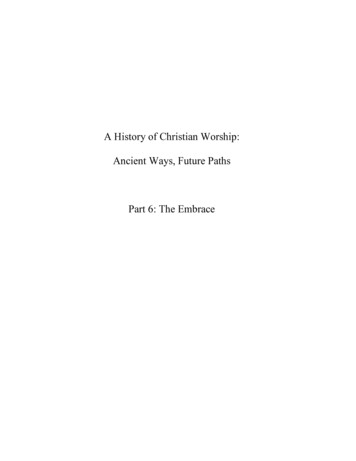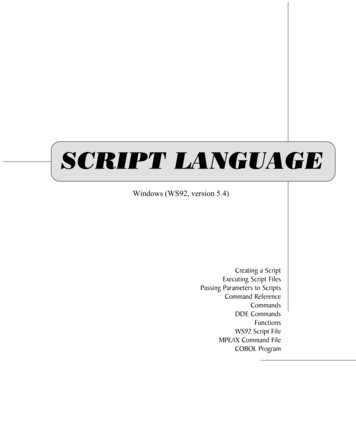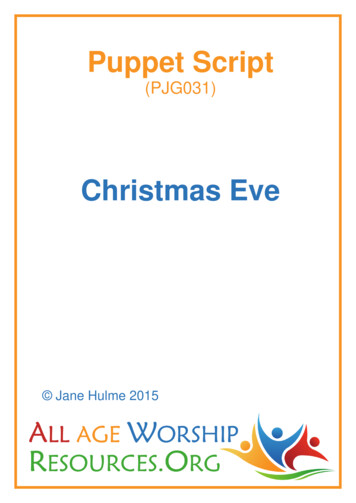
Transcription
A History of Christian Worship:Ancient Ways, Future PathsPart 6: The Embrace
A History of Christian Worship: Part 6 The EmbraceFade from black. Introduction.Narrator:As Christians, we seek an ongoing relationship with our Creator through various facets ofworship. Prayer, whether formal or informal, private or in community, helps us approachGod in worship and adoration. Contemplation on the nature of God and on His Wordprovides us with greater insight for daily living. Ministry is the hands and feet of ourworship, the fulfillment of the Gospel commandment to go into the world and serveothers. The expression of God’s story through worship, whether experienced in thepractice of prayer and contemplation or in the sacrificial giving of self through serviceand ministry, is part of the ongoing story we know today as the history of Christianworship.Fade to opening credits: Ancient Ways, Future Paths: A History of Christian Worship. TheEmbrace: Prayer, Contemplation, Service and Ministry. Fade to black.Fade from black to middle credits: The Embrace: Prayer and Contemplation. Fade to blackand then to narrator.Narrator:God’s people have always been a people of prayer.2
A History of Christian Worship: Part 6 The EmbraceFr. Robert Reed (Network Director, Catholic TV):Our attitude when we worship is, without shame, placing ourselves before God ascreatures. Small, not insignificant. In fact, incredibly significant, but small before theOne who is so great. Attitude for me in worship is beautifully represented in the posturethat I took when I was ordained That posture, of lying prostrate, face down on theground, remains in my head as the attitude that I bring, that we must all bring, to worship.If not physically, then spiritually, mentally we prostrate ourselves before the great One,the Creator, the Redeemer, the Sanctifier, God: Father, Son and Holy Spirit.Dr. Joyce Ann Zimmerman, C.PP.S. (Institute for Liturgical Ministry):Sometimes I like to describe prayer as basking in God’s presence. That term, ‘basking’,is kind of a nice one in that it brings to mind joy and warmth. Basking brings to mind awholesomeness and a kind of a relaxation and a being enveloped by God.Narrator:In the Scriptures, we find prayers of intercession, thanksgiving, deliverance, andconfession throughout the Old Testament, and in particular, the Book of Psalms. It is not,therefore, a surprise that worshippers in the New Testament church continued theexample of prayer found in Jewish worship, meeting several times each day in public andprivate to raise their voices in adoration and supplication to God.Female reading Psalm 55:17:Evening, and morning, and at noon, will I pray, and cry aloud: and he shall hear myvoice. – Psalm 55:173
A History of Christian Worship: Part 6 The EmbraceDr. Joyce Ann Zimmerman, C.PP.S. (Institute for Liturgical Ministry):It would be inconceivable to think that the early Christian community, with Jewish roots,would not be strongly influenced by the Jewish practices: the Jewish practices of severaltimes a day turning to God in prayer was early on taken into Christian practice.Narrator:In the early church, daily prayer would also include the reading of Scripture and the singing ofPsalms and spiritual songs.Dr. James R. Hart (President, Robert E. Webber Institute for Worship Studies):The ancient structure of prayer, this goes back to the Benedictine structure fifteen, sixteenhundred years ago, actually it goes back before that, it goes back to the Jewish synagoguestructure. The ancient structure of worship, of prayer is a threefold structure. The firstpart of that is Psalms, and by the way, Psalms is the backbone actually for all three partsof prayer The Psalms are both God’s word to us as well as our praise and prayer toGod. Second part is the Word: the Word as read and proclaimed And the third part arethe actual prayers proper, including the written prayers like the Lord’s Prayer andextemporaneous prayers of our own composition to the Lord.Narrator:In the Jewish pattern of prayer, a thanksgiving prayer would have three distinct parts: first, itwould invoke the name of God; second, it would describe some aspect of God’s story as4
A History of Christian Worship: Part 6 The Embracerevealed in history; third, it would conclude with a petition. This pattern can still be found inthe prayer of the church today.Dr. David W. Fagerberg (University of Notre Dame):collect prayer on a Sunday, you will hear God named, some characteristic or activity ofGod recited and then a petition made. That same structure is also the basis of theEucharistic prayer. Well, the reason for reciting the holy history in the second step is sothat we can adjust our petition to what God wants to give. The object of prayer is not totalk God into giving me something He doesn’t want to do. The object would be for me tobe prepared to receive what He wants to give.Narrator:One example of an Old Testament prayer that has influenced Christian prayer is the Shema,which comes from the book of Deuteronomy and is an essential part of both morning andevening Jewish prayer.Female reading The Shema:Hear, O Israel, the Lord our God, the Lord is One. – The Shema, Deuteronomy 6:4Dr. Tom Boomershine (Founder, Network of Biblical Storytellers):Clip 15 - :18 - :59The most ancient confession of the religion of Israel was the Shema: Hear, O Israel, theLord our God, the Lord is One. You shall love the Lord your God with all your heart,and with all your soul, and with all your strength. Write these things that I am saying to5
A History of Christian Worship: Part 6 The Embraceyou this day on your heart. Those are the fundamental practices of the worship of God,and the Shema was, and has been, throughout the entire history of Israel, the mostfoundational confession in prayer each day and in worship.Narrator:In the Middle Ages, Christians adapted the form and context of the confessional Shema intowhat is called The Jesus Prayer.Female reading The Jesus Prayer:Lord Jesus Christ, Son of God, have mercy on me, a sinner. – The Jesus PrayerDr. Tom Boomershine (Founder, Network of Biblical Storytellers):Clip 15: 1:00 – 1:50In Christianity, the Shema was not as widely used as a foundational confession. But acentral prayer that developed was what has been called the Jesus Prayer. It emerged inthe middle ages. I know the Jesus Prayer primarily in Russian: (Russian languagespoken). Lord Jesus Christ, Son of God, have mercy on me, a sinner. That prayer hasbeen the foundational prayer in the Orthodox tradition, and in various forms it has been aprayer in the Catholic tradition and in various Protestant churches.Narrator:The Jesus Prayer is an example of a prayer with ancient roots and, yet, contemporaryappeal in many church traditions.6
A History of Christian Worship: Part 6 The EmbraceDr. Tom Boomershine (Founder, Network of Biblical Storytellers):Clip 17 - :38 – 1:11The Jesus Prayer, the Shema in some contexts, have been seen as central to the ancienttraditions that have been integrated then into modern liturgical practice, and then learnedand internalized and spoken by and memorized as forms of prayer by people, both in theirpersonal lives but also in the life of the community.Narrator:Another prayer with origins in the Scripture, specifically the New Testament Gospels ofMatthew and Luke, is what is commonly known as “The Lord’s Prayer,” perhaps themost cited of all Christian prayers. Some refer to this as “The Disciples’ Prayer” sincethis prayer of Christ was in response to His disciples’ request to teach them how to pray.Female reading the Lord’s Prayer:After this manner therefore pray ye: our Father which art in heaven, hallowed be Thyname. Thy kingdom come, Thy will be done, in earth as it is in heaven. Give us this dayour daily bread, and forgive us our debts, as we forgive our debtors. And lead us not intotemptation, but deliver us from evil: for thine is the kingdom, and the power, and the glory,for ever. Amen. – Matthew 6:9-13Narrator:Disciples of Jesus used this prayer in the early history of the Christian Church, as seen inthe Didache, a writing from the late first or early second century, that encouragedChristians to pray the Lord’s Prayer three times each day.7
A History of Christian Worship: Part 6 The EmbraceFemale reading the Didache:And do not pray like the hypocrites, but rather as the Lord commanded in thegospel: Our Father in heaven, holy be your name. Your kingdom come. Your willbe done, on earth as it is in heaven. Give us enough bread day-by-day. And forgiveus our debts, as we also have forgiven our debtors. And do not bring us to the timeof trial, but rescue us from the evil one. Pray this three times each day. – TheDidache 8:2-3Narrator:There are several versions of the Lord’s Prayer in use among Catholic, Orthodox andProtestant churches. Some traditions use the word “trespasses,” others use the word“debts,” and some traditions use the word “sins.” Additionally, some traditions includethe doxology “For thine is the kingdom, and the power, and the glory, for ever” at the endof the prayer as recorded in some versions of Matthew. What all Christian faith traditionshold in common is the inclusion of the Lord’s Prayer as an essential liturgical prayer,adding to a collection of well known prayers from the Scripture and church history thathave become ingrained in the hearts and lives of worshippers throughout the centuries.Dr. Tom Boomershine (Founder, Network of Biblical Storytellers):Clip 15 – 3:09 – 3:29These deeply internalized, remembered prayers have been a primary resource for theprayer of individuals, the prayer of the community, and the liturgical traditions of thechurch.8
A History of Christian Worship: Part 6 The EmbraceNarrator:The practice of Christian prayer modeled upon Jewish prayer and the Scripturescontinued with little modification through the early centuries of Christian worship asnoted by the early Church Fathers. Clement of Alexandria from the early third centurydescribes the act of raising hands during prayer. Hippolytus wrote about the practice ofmorning and evening prayer in detail in his early third century Apostolic Tradition.Church historian Eusebius and the Apostolic Constitutions, both from the fourth century,also write of the practice of daily prayer in the morning and evening.Female reading Hippolytus:Let every faithful man and woman, when they have risen from sleep in the morning, beforethey touch any work at all, wash their hands and pray to God, and so go to their work Pray before your body rests on the bed. Rise about midnight, wash your hands withwater, and pray.And likewise rise about cockcrow, and pray If you act so, all youfaithful, and remember these things you will not be able to be tempted or to perish, sinceyou have Christ always in memory. – Hippolytus, Apostolic Tradition, XLINarrator:The most significant change in the early centuries of the Church emerged from the desertof Egypt, where a group of Christians seeking to renounce the world and immersethemselves in the practice of prayer and contemplation gave birth to a new worshipmovement known as monasticism.Dr. Joyce Ann Zimmerman, C.PP.S. (Institute for Liturgical Ministry):9
A History of Christian Worship: Part 6 The EmbraceFrom early on in Christianity, we have a movement that we now call the Desert Fathers,and I suspect there were some others there, too, where those who really wanted to livethis ideal of total commitment, a life filled with the idea of becoming totally aware ofGod’s presence to us. They would go off in the desert, which is an image to say theywould go away from all the distractions that tend to keep us from God, to liveChristianity, to live the Gospel in its fullness.Narrator:One significant contribution in the prayer of the church to come from the monasticcommunity was the expansion on the idea of fixed hour prayer. Saint Basil, in the fourthcentury, crafted a rule that called for prayer at eight times during the day and night.Dr. James R. Hart (President, Robert E. Webber Institute for Worship Studies):The first time I went to a monastery, one of the things that impressed me so much wasthis community of men who actually met together and prayed four, five, six, seven timesa day together as a community they would pray through the day in their work, in theirstudy. They saw all that as being prayer.Narrator:These regular intervals of prayer are what we know today as the daily office or theLiturgy of the Hours. This cycle of prayer reflected the Jewish tradition of the day andSabbath beginning at sunset. Thus, prayers are offered beginning at the end of the10
A History of Christian Worship: Part 6 The Embraceworkday, at bedtime, during the middle of the night, at dawn, at the sixth and ninth hoursof the morning, at noon, and at the third hour of the afternoon.Brian McLaren (Author, Finding Our Way Again):One of the secrets of the spiritual life is this idea of practice A practice is somethingwithin our power that helps us to achieve something that’s currently beyond our power.Brian McLaren (Author, Finding Our Way Again):One of the most important practices is fixed hour prayer: that at certain times of the day,we pause and we have this awareness, not just that we’re praying, but that we’re prayingwith all of our brothers and sisters, and that at certain times of the day there are certainthings that we remember and focus on together.Narrator:In addition to fixed hour prayer, the monastic community significantly contributed toworship practices through the fostering of contemplation and meditation in daily life.Benedict of Nursia in the early sixth century was instrumental in defining the framework,or rule, by which the monastic community could dedicate itself to a life of prayer, work,and contemplation.Dr. Joyce Ann Zimmerman, C.PP.S. (Institute for Liturgical Ministry):11
A History of Christian Worship: Part 6 The EmbraceBenedict’s rule is very simple. It is very pastoral and very fatherly. Benedict’s rule isnot a burden for the monks, but really frees the monks to try to live this ideal ofChristianity that says total commitment to Jesus Christ and living the Gospel.Dr. Tom Boomershine (Founder, Network of Biblical Storytellers):Clip 18 – :48 - 2:03In the monastic communities, people were drawn to those communities as places wherethey could spend the majority of their time, in many instances, or regularly in theBenedictine communities, five or six times a day for forty-five minutes to an hour, inprayer and worship. They were drawn to the life of contemplation, of sitting in God’spresence, and being open to the movement of God’s spirit, and of meditation, ofmeditating and contemplating the word of God. So the Benedictine communities everyworship, five times a day, would recite the Psalms, and once they had gone through the150 Psalms, they would go back and do it again. So in the course of a year, they’d gothrough the Psalter several times, and over a period of time, those Psalms become deeplylearned, internalized, and part of simply their life, their memory, their basic thought.Narrator:Monastic life also introduced the idea of private and public silence, in contemplation andworship, as a spiritual discipline.Dr. Joyce Ann Zimmerman, C.PP.S. (Institute for Liturgical Ministry):12
A History of Christian Worship: Part 6 The EmbraceWhat characterizes both the Desert Fathers and the monastic movement is most of theday, if not absolutely all of the day, is spent in silence. The difference is in the monasticcommunity, we learn to live this silence together, and it’s together as the Body of Christ,rubbing shoulders, rubbing all of the kind of warts off, rubbing together all the knots thatwe come to perfection together.Narrator:While contemplation and meditation are often used interchangeably, the act ofcontemplation in worship refers to silent reflection, while meditation may comprise avariety of forms.Dr. Joyce Ann Zimmerman, C.PP.S. (Institute for Liturgical Ministry):Contemplation, an ancient prayer practice, is not words. Contemplation is simplysurrendering one’s self, giving one’s self over to that divine presence who chooses to bethere for us. Meditation, on the other hand, can take many forms, and it’s a little bit moreof a cerebral kind of an activity.Narrator:One type of meditation is lectio divina, meaning divine reading, which focuses on God’sWord. There are four movements or components to lection divina: to read, meditate,pray, and contemplate the Scriptures. Though this practice dates back to the time ofAmbrose and Augustine, Benedict introduced the practice to the monastic community inthe sixth century.13
A History of Christian Worship: Part 6 The EmbraceDr. Joyce Ann Zimmerman, C.PP.S. (Institute for Liturgical Ministry):So what we would do in lectio divina is take a Scripture passage and slowly read it,preferably out loud, and then meditate on that passage, and ask ourselves, ‘What is Godsaying to me here? What is Christ really saying to me for my life in this parable?’ So it’sthinking about it, it’s ruminating about God’s Word, it’s taking God’s Word into ourheart, and it’s considering how does that Word challenge me? How does that Wordcomfort me? How might that Word lead me to live the Gospel differently every day?Narrator:The practices of daily prayer at regular intervals, contemplation and meditation continuedas the church moved into the Middle Ages. As music developed in the church, Psalmsand prayers were being set to music, but otherwise the practice of fixed hour prayercontinued in monastic communities and local parishes by the clergy. Since public prayerand the daily office was said in Latin rather than the language of the people, it remainedprimarily a function of the clergy rather than the people.The 16th century brought the greatest reform in worship relating to prayer. Brevaries,which were books that contained the prayers, hymns, Psalms and liturgy of the DivineOffice, had existed in various forms since the time of Benedict and could be revised byeach bishop for use in the local diocese.The Council of Trent in 1545 designated asingle Roman breviary to be used in all parishes, and though it has been reformed sincethen, it still serves as the basis for the Liturgy of the Divine Hours today.14
A History of Christian Worship: Part 6 The EmbraceAt the same time in the Anglican Communion, a movement was underway to devise auniversal prayer book for liturgical worship. The resulting Book of Common Prayer, firstpublished in 1549 and edited chiefly by Thomas Cranmer, was the first to include theliturgy in English. The Book of Common Prayer was significantly made up of Scriptureand helped to simplify the daily office for the people. Though it has been edited manytimes since its initial publication, The Book of Common Prayer is still used today inmany churches worldwide.Dr. J. I. Packer (Author, Knowing God):I am asked to cite from memory a sample of the prayer book Almighty and mostmerciful Father, we have erred and strayed from your ways like lost sheep. We havefollowed too much the devices and desires of our own hearts. We have offended againstyour holy laws. We have left undone things that we ought to have done, and we havedone things that we ought not to have done, and there is no health in us. But thou, OLord, or You, I should say, You, O Lord, have mercy upon us, miserable offenders. Sparethem, O Lord, who confess their faults. Restore them that are penitent; According toYour promises declared to mankind in Christ Jesus our Lord. And grant, O most mercifulFather, for his sake; that we may hereafter live a godly, righteous, and sober life, To theglory of Your holy Name. Amen.Narrator:The rise of Methodism in the eighteenth century brought with it the concept of a weeklyservice for prayer and instruction. This formed the basis in America for midweek prayer15
A History of Christian Worship: Part 6 The Embraceand Bible studies. The frontier revivals of this period also inspired a generation ofpioneers to adopt contemplative spiritual practices.Dr. Tom Boomershine (Founder, Network of Biblical Storytellers):Clip 18 – 3:20 – 3:53So in the United States in the frontier period, people learned and practiced a kind ofmeditation and contemplation by reading the Bible, and reading it to themselves bycandlelight at night, and cabins, places on the frontier. That became a central way ofexperiencing God’s presence in what was frequently a very alien environment.Narrator:The rise of Free Church and Anabaptist traditions has brought a greater emphasis oninformal and non-liturgical prayers as part of corporate worship.Dr. Tom Boomershine (Founder, Network of Biblical Storytellers):Clip 18 – 4:58 – 5:37My experience has been that people’s desire to be in communication with God, and theways in which they develop that, has many different forms, but all of them are groundedin meditation on the word of God, on the scriptures, and on sitting in a contemplativemode, being open to whatever it is that God may seek to say to us.16
A History of Christian Worship: Part 6 The EmbraceDr. James R. Hart (President, Robert E. Webber Institute for Worship Studies):You need to have both extemporaneous prayers and liturgical prayers. Liturgical prayersgive a structure and a formation to the thoughts that are being expressed within thecommunity and they often reflect hundreds, if not thousands of years, of the history ofGod’s people and the way they approach God in prayer But then, at the same time, wehave needs, we have thoughts, we have our own sensibilities, we have our own emotionsthat we need to express to the Lord in our prayer time, and I think that the Lord wants usto be very authentic with that as well, so having both, I think, are actually very important.Narrator:In fact, the practice of public and private prayer is unique to each worshipper and eachcongregation or parish. Private prayer is important for strengthening our own personalrelationship with God.Dr. Kathleen Harmon, S.N.D.de.N. (Institute for Liturgical Ministry):Private prayer is the prayer that I shape, the prayer that you shape. The content of myprivate prayer is chosen by me. It’s connected to what’s going on in the circumstances ofmy life, what’s happening today, what’s happening in the world. My private prayer is allthe forms of conversation I have with God about what’s going on in my life.Dr. J. I. Packer (Author, Knowing God):I start off with adoration and praise as I come into God’s presence. I spend time on that.I believe that we, all of us, should. I move to confession, acknowledgement of my sins,17
A History of Christian Worship: Part 6 The Embraceshortcomings, weaknesses, whatever in which I need God to help me. I move on topetitionary prayers for folk for whom I have a concern, causes for which I have aconcern. And I give thanks; I make a point of giving thanks to God for mercies, goodthings enjoyed since last I prayed.Dr. James R. Hart (President, Robert E. Webber Institute for Worship Studies):I find that sometimes, when I don’t know how to pray, when I’m in a situation that Idon’t know what to do, finding the written prayers of the historical church really helpedme to formulate my thoughts and sometimes helped me to form my emotional responsesas well But, at the same time, I also like to have the freedom to be able to express to theLord directly like I’m talking to you, like I’m talking to anybody, where I can just talk toHim and say, “Lord, you know, I don’t understand this. Why is this happening?” Or“God, thank you for what you’ve done in my life today. This is just tremendous.”Narrator:While private prayer focuses inward, public prayer focuses outward to the worshippingcommunity. It is vital for uniting the Body of Christ in a common purpose and voice inseeking God’s guidance, providence and blessing.Dr. Kathleen Harmon, S.N.D.de.N. (Institute for Liturgical Ministry):Public prayer is really communal prayer. It’s the whole community coming together andit has a structure to it that enables everyone to enter together into common prayer.18
A History of Christian Worship: Part 6 The EmbraceDr. Kathleen Harmon, S.N.D.de.N. (Institute for Liturgical Ministry):Private prayer is the way I choose to connect to God individually. Communal prayer isthe whole family of the church coming together. If I don’t have enough private prayer inmy life, I’m going to be angry when we gather for communal prayer ‘cause I’m feelingI’m not getting my time with God. But when my private prayer is in place, my publicprayer with the family of the church is very nourishing and very satisfying.Fr. Ted Bobosh (St. Paul Orthodox Church):And so we have the history of salvation and all the things that God has done intersectwith the daily lives of people, and here we bring into the church our concerns and ourworries. We pray in our liturgy for the president of the country, for the weather, for theabundance of the fruits of the earth, that we have good crops. We pray for the sick andthe suffering and the travelers and we pray for all the things that people are worried aboutand concerned about in their own lives, and as I said, that intersects with the history ofsalvation and all that God has done.I bring my own concerns and I encounter God here.Lester Ruth, PhD (Robert E. Webber Institute for Worship Studies):I believe one of the most essential capacities in order to be able to pray well in a Christiancongregation is to know the Bible well, especially Bible stories We often assume thatthe Bible stories should just be taught to children, but if you look at the history ofChristian worship, one of the recurring features of public Christian praying is thecontinual recitation of God’s mighty acts of salvation So I think to be able to pray well19
A History of Christian Worship: Part 6 The Embracein a Christian congregation involves not only knowing your own heart well, but inknowing the story of God according to the Scriptures well.Narrator:In today’s church, there are a variety of prayer books, missals, devotionals, and resourcesfor strengthening the public and private prayer of the church.The challenge forworshippers is finding the still, small voice in prayer and contemplation rising above thenoise and distraction of today’s busy culture and lifestyles.Fr. Robert Reed (Network Director, Catholic TV):One thing that I don’t do enough is to very simply place myself before God in silence. Ithink the world that we live in today, life being so fast paced, so much stimulation, itmakes it very difficult for any one of us to stop and be silent.Dr. Tom Boomershine (Founder, Network of Biblical Storytellers):Clip 19 - :36 – 1:41I think there is an impatience with silence, with apparently nothing happening, that is achallenge for people in this age in which we are so busy, and in which our media are justcoming at us all the time with constant stimulation. So we come to expect that from ourreligious experience. You know, we can turn it on at any time and get that. I think thereis a sense in which there is a need to withdraw from that kind of constant bombardmentwith new efforts to stimulate us, to do something, to buy something or sell stuff, and to20
A History of Christian Worship: Part 6 The Embracesimply learn the practice of sitting and being with God and of listening to what it is thatGod may have to say to us.Brian McLaren (Author, Finding Our Way Again):I love to be outdoors. I love trees and plants and wildlife. So, for example, I’m veryinterested in birds. Well, if you want to learn, let’s say see or hear, a rare bird, you’vegotta spend a lot of time walking and listening. You can’t guarantee that the bird you’relooking for is going to be there when you’re looking, but unless you get out there andyou’re listening and you’re attentive, you’re never going to experience it. And I think it’sthis way with the grace of God as well. God might want to give us some insight. Godmight want to help us see or hear some new thing, and we have to develop the practice ofgetting out with our eyes and ears open so we’ll be ready when that moment comes.Narrator:Just as the apostles encouraged early believers to “pray without ceasing” in preparation for thereturn of the Lord, so the Church continues in its ongoing dialogue with God through prayer,contemplation and meditation, with eyes and ears open and hearts ready and attuned to God’sgrace and insight for His people.Fade to black.21
A History of Christian Worship: Part 6 The EmbraceFade from black to middle credits: The Embrace: Service and Ministry. Fade to black andthen to narrator.Narrator:Worship inspires us to pursue holiness and right living in our daily lives as we growcloser in relationship with God. The outward sign of our transformation of heart andmind, and an essential part of the Christian life, is how we serve and minister to ourneighbors and our world.Brian McLaren (Author, Finding Our Way Again):One of the passages in the New Testament that I think is most important forunderstanding worship comes in Romans 12. And there the Apostle Paul says, “In viewof God’s great mercy for us, I beg you to present your bodies as living sacrifices, holyand acceptable to God, and this is your spiritual service of worship.” And the picturethere is not that we worship God primarily in a building, in a meeting, at a fixed hour ona Sunday morning, but that the worship that really God is after is the worship that comesin our daily lives. And then it’s explained later in the chapter. It has to do with whetherwe try to get revenge on people, or whether we do good to those who do evil to us,whether we show hospitality or not, whether we give generously or not. So the worshipthat God’s interested in is a worship that’s shown in our daily lives, in this way of life.22
A History of Christian Worship: Part 6 The EmbraceNarrato
Dr. James R. Hart (President, Robert E. Webber Institute for Worship Studies): The ancient structure of prayer, this goes back to the Benedictine structure fifteen, sixteen hundred years ago, actually it goes back before that, it goes back to the Jewish synagogue structure. The ancient structure of worship, of prayer is a threefold structure.











